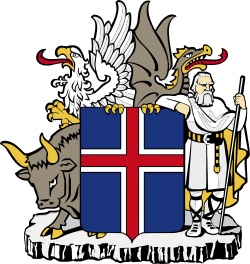Icelandic independence movement
Part of a series on the |
||||||||||||||||||||||||
|---|---|---|---|---|---|---|---|---|---|---|---|---|---|---|---|---|---|---|---|---|---|---|---|---|
| History of Iceland | ||||||||||||||||||||||||
 | ||||||||||||||||||||||||
| Middle Ages | ||||||||||||||||||||||||
|
||||||||||||||||||||||||
| Modern era | ||||||||||||||||||||||||
|
||||||||||||||||||||||||
| Related topics | ||||||||||||||||||||||||
| Timeline | ||||||||||||||||||||||||
| Iceland portal | ||||||||||||||||||||||||
The Icelandic Independence movement (Icelandic: Sjálfstæðisbarátta Íslendinga) was the collective effort made by Icelanders to achieve self-determination and independence from the Kingdom of Denmark throughout the 19th and early 20th century.
Iceland received a constitution and limited home rule in 1874. A minister for Icelandic affairs was appointed to the Danish cabinet in 1904. Full independence was granted in 1918 through the Danish-Icelandic Act of Union. This was followed by the severance of all ties to Denmark with the declaration of the republic in 1944.
Background
Through the signing of the Old Covenant in 1262, following the civil strife of the Age of the Sturlungs, Icelanders had relinquished sovereignty to Haakon IV, King of Norway. Iceland remained under Norwegian kingship until 1380, when the death of Olav IV of Norway extinguished the Norwegian male royal line. Norway (and thus Iceland) then became part of the Kalmar Union, along with Sweden and Denmark, with Denmark as the dominant power.
Unlike Norway, Denmark did not need Iceland's fish and homespun wool. This created a dramatic deficit in Iceland's trade, and as a result, no new ships for continental trading were built. The ensuing centuries saw Iceland becoming one of the poorest countries in Europe.

Nationalist movement
Around the middle of the 19th century a new national consciousness was revived in Iceland, led by Danish-educated Icelandic intellectuals who had been inspired by romantic and nationalist ideas from continental Europe. The most notable of these were the so-called Fjölnismenn—poets and writers for the journal Fjölnir— Brynjólfur Pétursson, Jónas Hallgrímsson, Konráð Gíslason and Tómas Sæmundsson.
Meanwhile, an independence movement developed under Jón Sigurðsson. In 1843, a royal decree re-established a national parliament, the Althing, as a consultative assembly. It claimed continuity with the Althing of the Icelandic Commonwealth, which had remained for centuries as a judicial body and had been abolished in 1800. The advocates of Icelandic independence pursued their aims peacefully, soliciting Danish officials via legal means.
The struggle for independence reached its height in 1851 when the Danes tried to pass new legislation, the requests of which the Icelanders ignored. The Icelandic delegates, under the leadership of Jón Sigurðsson, passed their own proposal, much to the displeasure of the King's agent, who dissolved the meeting. This caused Sigurðsson to rise up with his fellow delegates and utter the phrase Vér mótmælum allir ("We all protest").
Home rule and independence
In 1874, a thousand years after the first acknowledged settlement, Denmark granted Iceland home rule. By the end of the 19th century, the various efforts made on behalf of Iceland had their desired result. The constitution, written in 1874, was revised in 1903, and a minister for Icelandic affairs, residing in Reykjavík, was made responsible to the Althing . Hannes Hafstein served as the first Minister of Iceland from 31 January 1904 until 31 March 1909.
The Act of Union, signed on 1 December 1918 by Icelandic and Danish authorities, recognized Iceland as a fully sovereign state (the Kingdom of Iceland), joined with Denmark in a personal union with the Danish king. Iceland established its own flag and asked Denmark to represent its foreign affairs and defense interests. The Act would be up for revision in 1940 and could be revoked three years later if agreement was not reached. Union through the Danish king was finally abolished altogether in 1944 during the occupation of Denmark by Nazi Germany, when the Alþing declared the founding of the Republic of Iceland.
See also
- Kingdom of Iceland
- Danish realm
- Constitution of Denmark
- Greenlandic independence
- Faroese independence
References
| |||||||||||||||||||||||||||||||||||||||||||||||